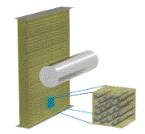Mechanical and Materials Engineering, Department of

Department of Engineering Mechanics: Dissertations, Theses, and Student Research
Date of this Version
5-2011
Document Type
Thesis
Abstract
Understanding the characteristics and structure of materials is of importance in proper modeling and effective design of many products. Complex materials such as polymers, structured material systems, or biological materials provide a particular challenge to many of the traditional methods for doing this. In this dissertation I study the use of ultrasonic wave techniques to characterize several complex materials. These include plastically deformed and aged polycarbonate (PC), a structured PC plate with water filled cavities, bovine bone, and an elastomer used as a skin simulant. In each case, this work was part of a larger project that studied different aspects of related problems.
Ultrasonic methods use high frequency mechanical waves to interrogate the structure and properties of materials. As a result, ultrasonic waves are capable of characterizing the response of materials during high frequency loading and can characterize structure at fairly small sizes. As such, the ultrasonic techniques provide a special window of characterization that may provide important information on the response of complex materials such as polymers and structured material systems such as is seen in bone.
In the study of anisotropic ultrasonic waves in plastically worked and then thermally aged samples, it is shown that the large drop in toughness seen with aging does not correlate closely with the gradual changes observed in the ultrasonic wave speeds. In developing a structured polymer by producing different topologies of water-filled channels by rapid prototyping with a pseudo-PC material, it was shown that one can make plates with overall ultrasonic wave speeds between the speeds in pseudo-PC and water, with the response under some topologies showing close to linear interpolation between the two materials. In studying cow bone, we were able to evaluate the amplitude and attenuation using contact transducers in the pulse-echo mode, and this provided an estimate of the critical angle for shear wave formation in submerged ultrasonic in a water tank. In evaluating the viscoelastic properties through contact surface reflections, the properties of reference materials were evaluated using the standard pulse-echo method, but preliminary results of the contact-reflection method did not correlate with these results (see the master thesis of Jonathan Hein for follow-up work that was done to obtain good correlations).
Advisers: Mehrdad Negahban and Joseph A. Turner


Comments
A thesis Presented to the Faculty of The Graduate College at the University of Nebraska In Partial Fulfillment of Requirements For the Degree of Master of Science, Major: Engineering Mechanics, Under the Supervision of Professor Joseph A. Turner and Professor Mehrdad Negahban. Lincoln, Nebraska: May, 2011
Copyright 2011 Charles Landais